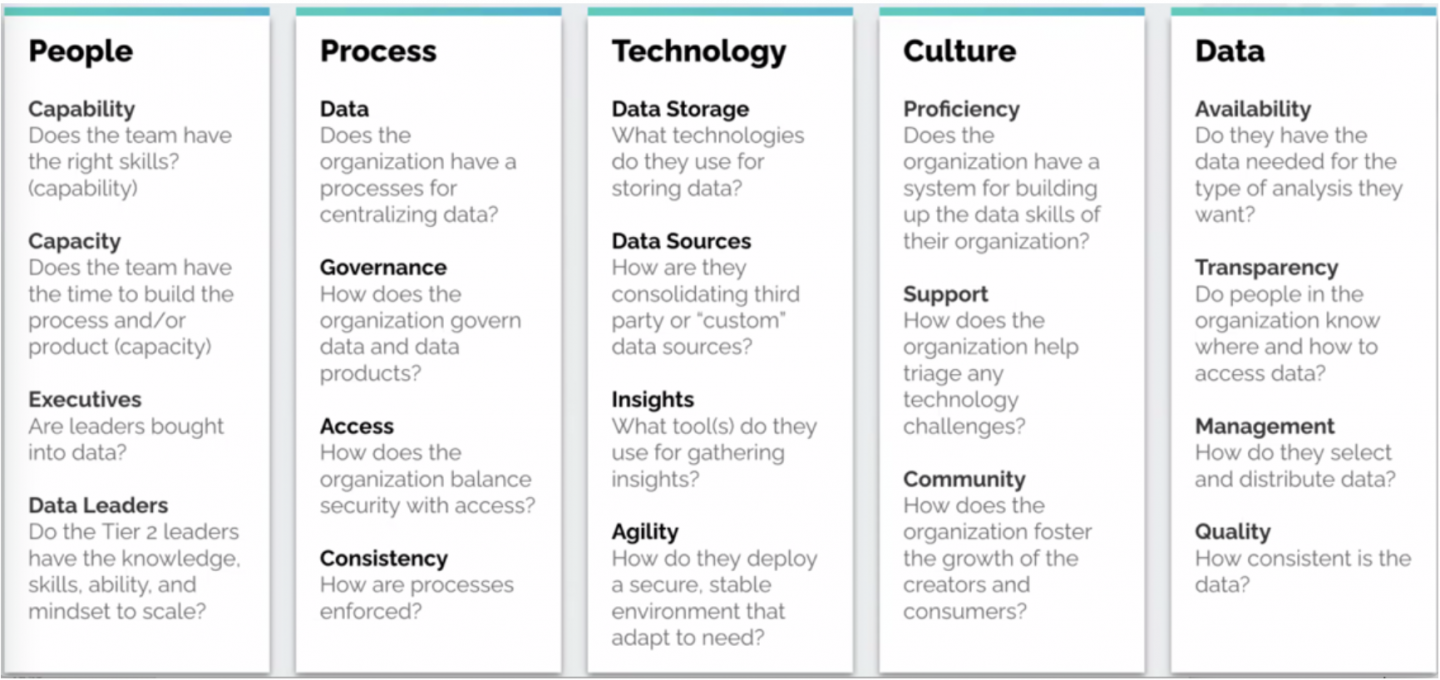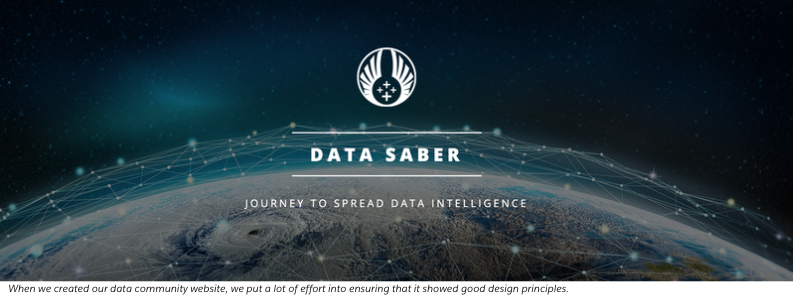
DLC Essentials: How to Build a Data Culture


Having a strong data culture within your organization is more crucial than ever. A robust data culture fosters a mindset where data is considered a core asset and encourages employees at all levels to engage with analytics to solve problems and identify opportunities.
Despite being so important, most companies have a weak data culture, if any at all. Companies with a well-established data culture are better positioned to navigate the complexities of the modern business landscape, leading to sustained growth and success, but it takes time, effort, and complete buy-in to create one.
Creating a data-driven culture
So how do you build a strong data culture? Data Leadership Collaborative shares perspectives from six data leaders below on their experiences and best practices.
Sarah Bartlett, BI Enablement Director at JLL, notes that “when I was told that I would be moving away from a traditional data tool toward a more modern visualization solution, I’ll admit that I had my doubts. This anxiety about the new and unknown is natural, of course. It’s your defense system coming into play. When you’re ingrained in a certain way of doing things, you may need a bit of a push.”
The tipping point for Sarah came when she realized she could map out all of her company’s locations across the UK with the click of a button, something she never could have done with a traditional data toolset.
Sarah has found five strategies that move people’s hearts and minds toward embracing data culture.
- Use inspiration from everyday life. Data literacy can’t be presented as an esoteric process, because it’s the ability to read, understand, communicate, and create content with data, and that’s becoming a critical skill almost everywhere. As you begin to understand how to build a data culture, raise examples from daily life to show how relevant data has become. If you interact with a Fitbit or another brand of sports watch, you’ve already achieved a certain level of data literacy. If you’ve spent a few moments reading a chart showing COVID rates, you are interpreting data.
- Encourage critical thinking about data. Thinking critically about data doesn’t mean you approach every chart or visualization as if it’s suspect. It’s more about taking a step back and asking questions before you take the data you see at face value. Is the data sourced correctly, and can you confirm that it’s credible? Is there any way it could be misinterpreted, and could there be negative consequences? If there’s an insight presented, could it be visualized in a slightly different way that better brings this theme to the forefront? Strong data cultures encourage this kind of inquiry, because people know their data may be used to drive important decisions.
- Establish platforms for idea sharing. If people are unaware of how other people in the organization are looking at data, you can hardly blame them for not collaborating. That’s why it’s essential to build platforms where they can speak to each other and share ideas. These vehicles could be relatively basic, like a group in Slack, Google Chat, Confluence or even user group meetings. The point is that you have a way to share your work, ask questions, and build each other’s skills through tutorials, blog posts, tips and tricks, or anecdotes about how you’ve tackled a challenge. Encouraging this kind of collaboration creates a momentum about learning that’s indicative of strong data cultures.
- Capitalize on FOMO (The Fear of Missing Out). In strong data cultures, good news spreads quickly. If there’s excitement about a new way of doing things, people want to be a part of it. If a specific department is clearly getting a lot of benefit out of the way they use data, their colleagues will not want to miss out. In strong data cultures this also has a positive dynamic to it. Based on my experience it’s as much the fun of getting in on the action than missing out on it altogether.
- Find champions within the business. Data-driven organizations needn’t and shouldn’t top out at the Center of Excellence level. To go beyond these borders, find colleagues with challenging business decisions and connect them to what you’re doing with analytics and visualization. These individuals will show a passion for data and analytics and will tend to make themselves known naturally. For every champion you create in the business who supports data-driven decisions and amplifies the work of the Center of Excellence, the dividends can be significant. Once again, you are creating positive momentum that fans out through the organization.
From community to culture
Eva Murray, Director of Stride Career Coaching and a Technical and GTM Advisory at Gemini Sports Analytics, notes that creating a data community is a step toward building a data culture, but the two are not synonymous. In practice, a data culture is larger than its constituent data communities in an organization.
Data communities are structured entities with a process, scheduled meetups, and specific people. Data culture, on the other hand, is everyone’s way of working, whether they are part of a data community or not. Even if they don’t participate actively, people in a data culture see the value of working with data and they can do it effectively themselves.
For Murray, a data culture means that data becomes part of every decision people make when they have a business decision to think about. They say: Well, what does the data tell us about this? If we look at the numbers, what seems sensible? They also need to bring in experience and intuition, of course, because it’s not all about the numbers. Again, a data culture is a way of working, always questioning the business decisions, the budget decisions, based on the data science.
A data community is possible without a data culture, but in Murray’s experience it will not thrive over the long term. Otherwise, a year after all the passionate people have done all the work – offered showcases, hung up posters, and educated people – there may be no lasting change around them at all. Ideally the community works in parallel with the culture as it grows.
Another important consideration is that you don’t have to work in a database or IT company to make data important to you. A data culture can grow in any sort of company, in any industry, because everyone generates data. At Murray’s local zero waste shop, they know exactly what she has purchased and they can track that over time. They might use this data to customize specials in an email newsletter. The point is you can put data to work anywhere. You can even organize a community around it and develop a culture where it becomes so valued, it’s literally part of everyone’s way of thinking. That’s the ultimate goal.
Data culture as team sport
Mark Palmer, a former tech CEO who currently works as an Enterprise Software Industry Advisor for Warburg Pincus LLC, notes that a primary challenge to realizing a data culture is that working with data is complicated, and just 8% of the workforce in the United States have technical degrees. That leaves 92% outside the "data club."
Or does it? In Palmer’s opinion, working as a data leader to treat data as a team sport can help make the data rubber meet the business road faster for all. Teamwork builds data fluency for everyone, not just a few scientists, and puts better information at the fingertips of anyone. Here Palmer shares five habits of cultures that treat data as a team sport.
- They hire data humanists. Erin Waldron, a data visualization expert, was once auto-rejected from a job based on the job description she wrote for herself. She was rejected because her undergraduate degree was in poetry, but she had long parlayed that skill into world-class data storytelling skills.
Erin is what Palmer calls a Data Humanist: someone with 80% domain skill and 20% tech skill. These are among the most critical workers of today and the future. In You Can Do Anything, George Anders notes that during the same five-year period, the U.S. economy added 540,000 tech jobs but two million tech-influenced jobs. So Data Humanist jobs are growing just as fast as technology jobs, and there are four times more of them.
Data humanists are critical in every industry: FinTech, MarTech, RegTech, HealthTech, GovTech, SportsTech, and HRTech. These are the jobs of the future. So the first principle of making data a team sport is to hire Data Humanists.
- They create a Data Fluency Operating System. Hiring data humanists is just the first step to building a team. Schooling in data is like schooling in language – you need practice to begin growing data fluency. So the second habit of an effective data team culture is to invest in a "Data Fluency OS" that transforms data literacy into data fluency.
A Data Fluency OS is a platform that helps staff work with data more easily every day. As a system of support, tools, processes, and objectives, it also makes working with the organization’s data a priority.
Who’s doing well here? Nearly 80% of 1,200 Scottish Environmental Protection Agency employees use data daily. SEPA provides education and support for every staff member, targets hiring employees with Data Humanist skill blends, and has tools and monitoring systems that check for success, failure, gaps, and a team to help fill those gaps.
- They build an Uncentralized Center of Excellence. One of the essential elements of a Data Fluency OS is what Palmer calls an "Uncentralized Center of Excellence." While COEs are common, they’re often centralized-- surrounded and separated by a moat.
But an uncentralized center partners with business users. They embed team members inside teams and work shoulder-to-shoulder. Their job is to teach Data Humanists how to fish, not to do the fishing for them.
An uncentralized center of excellence takes patience. It took seven years for SEPA to achieve 80% fluency. They have systems to measure fluency growth – who uses data, how often, and where they stumble. They run continuous training programs. They hold weekly lunch-and-learns about projects and recent ideas. But never in an ivory tower. Decentralized COEs work best.
- They hire Citizen Technologists. Teamwork is a two-way street. Too many companies draw bright lines between the CIO, CDO, or CAO office and the line of business.
Citizen Technologists are the yin to the yang of Data Humanists; they’re data fluent, primarily technical, but also have exceptional communication, collaboration, and coaching skills. Their job is to teach data humanists how to fish, not catch the fish for them. Citizen Technologists are teachers, mentors, and collaborators. They jump in when technology problems get tough. They ensure data humanists work safely and securely with the right data.
Like Data Humanists, Citizen Technologists are hard to find but essential.
- Their leaders walk the walk. Palmer once consulted for a tech company in year three of their annual goal setting offsite. The CEO shared their key results for the previous year. One objective, "40% of our new hires are women," was missed—they had achieved just 23%.
He asked the most basic analysis question: 23%... compared to what?
The CEO seemed confused.
Palmer realized he needed help. So he explained, "Well, if the previous year was 11%, you did well – short but trending better. But, on the other hand, if last year was 45%, you did worse. Which is it?"
Palmer’s slogan is: be like Toto.
Toto Wolff is the Team Principal and CEO of the Mercedes AMG Petronas Formula One racing team. He uses data every year, every day, every race, and sometimes, every lap. He invests in new technology and uses it to make day-to-day decisions by example. He convinced legendary F1 driver Lewis Hamilton to use a similar approach and look at data methodically every time he gets out of his car.
Successful data teams have data leaders like Toto Wolff, who walk the walk with data.
5 Rules of thumb to build a data culture
Glenn Exton, Head of Customer Business Analytics, NatWest Group, and Luke Stanke, Product Evangelist at Sigma Computing, come from very different perspectives when it comes to data, but are in full agreement on the urgent need to build data-driven cultures in organizations.
They’ve seen many of the same challenges as well. For example:
- A limited understanding of what’s required to create data culture. Technology or process by themselves will not create a flourishing data culture. So what is the right recipe?
- A general perspective on how each employee should use data in their role. This kind of misalignment can sap the excitement from learning and experimentation. How can a data leader make analytics personally compelling to everyone?
- A continued lack of clarity around the Chief Data Officer’s role. CDOs have too many jobs and not enough influence in many companies. How can a CDO identify the business value they enable, and how do they quantify and built it?
Based on these challenges, Stanke and Exton share are a few principles they use to create the right framework for data culture.
- It’s not a thing, it’s an intersection of things. Specifically, data culture lies at the intersection of people, process, data, and technology. The people part of this equation extends from IT experts whose job is to create platforms that allow information to be handled by analysts or leaders all the way to the service employees who are likely to interact with your customers most often.
- It requires sustained training. Whenever people are breaking new ground or being introduced to new tools and processes, sustained training becomes a must. You wouldn’t jump into a business analysis and valuation exercise without formal finance training. Data culture is no different. The last outcome you want is for employees to get a pitch on data culture, return to their desks and then say, “Okay, let me get back to my job.” Increasingly, the role of data culture is to highlight how data is some way everyone’s job.
- It’s highly personalized. Just as everyone tailors their use of a word processing program to their needs and objectives, data culture needs to be personalized to the individual to succeed. For example, personalized data quality dashboards can help employees see the immediate impact of their choices, while closed loop communication that builds people’s confidence will help them embrace curiosity rather than fear of failure. This personalization can come in the form of traditional learning pathways or more recent strategies like gamification. Of course, these tools should be for everyone, not just colleagues with the word “data” in their title.
- It needs C-level representation. Ideally the Chief Data Officer serves as the “tentpole” for data culture. In the same way a signature film can support an entire studio, a Chief Data Officer should serve as the one person in the organization who can stand up the data culture and showcase data capability to its highest degree. The CDO connects the top-down efforts of data culture, getting buy-in from fellow executives while enabling team leaders to spread the power of data throughout the organization. And CDOs or their equivalent should be able to say, “This is how we should build our data products. And this is what success looks like.”
- It has to permeate the whole company. Without data leaders who bring full understanding of the importance of data culture, who see the strategic value and know how to get there, data culture will exist only in pockets. That’s a non-starter, because no one in 2022 should view data as a magical art that is only practiced in one department.
More / Better / Different / Less
This mnemonic is one common-sense way to advance data culture and manage change in your organization. It can be used in concert with the question set below, which lays out 19 checkpoints you should consider when building a data culture.

Here are a few examples of putting it to use.
More
- If you have a great data culture vision but only scattered learning support or data champions, how can you bring more of both to the table and increase your odds of success?
- If you’re creating a dashboard showing data profiling on where things are working and where they’re not, but doing this in isolation, where could you join that up with personalized messages on the impact of what people are doing by not treating data seriously?
- Where could you add opportunities for learning pathways that will inspire people?
Better
- If you’re currently creating dashboards but doing so in isolation, how could you make them stronger by incorporating management’s perspective on the importance of data literacy and data management?
- If you’re swimming in dashboards that look beautiful but aren’t being used to create data-informed decision-making, how could you create a better core set that Sales, Marketing, Finance and other departments will use regularly?
Different
- If you have people, capability, budget, and processes but your data leaders have shared no vision for your data culture, how could you define one first and avoid a false start?
- If online data literacy training isn’t taking hold, should you look at lunch-and-learns or after-work meetups instead?
Less
- Are you acquiring analytics technologies ahead of your ability to optimize them?
- Are you relying on contractors too much as a source of talent, versus building that talent in-house?
Starting a cross-organizational movement
KT, a Senior Product Marketing Manager and Evangelist at Snowflake in Tokyo, has gone beyond just building a data culture in her own company. She has built a country-wide training and collaboration community that is creating data cultures across Japan.
In KT’s case, she was working at Tableau in Japan in 2017 when she felt the inspiration to create something. She found existing sessions for Tableau employees, customers, and users were helpful, but most of these were restricted to tips and advice on how to use the platform. There was little content on building a data culture, so the mission and vision of what she and her colleagues were trying to do were missing.
KT was wise to start small, with a pilot phase mentality. The launch of what eventually became Data Saber was a three-month trial targeting just ten people from different companies, and focused on the foundations of being data-driven in the workplace.
The 90-day structure of the program was deliberate on KT’s part, because she realized in 2017 that it had taken her four years to learn Tableau. Although this journey was fun, it felt too long for developing a single skill. She decided to compress the content needed to master Tableau into a much shorter and more efficient timeline.
From the beginning Data Saber was a success with its first class of members. One of them, who worked with Tableau, convinced her organization to use Tableau for everyone in her company. It was a genuine proof of the story KT and her colleagues were trying to tell about data-driven culture.

Seven years post launch, Data Saber has more than 1,200 participants who have completed its program and are spreading the message of data-driven culture in their organizations.
KT shares five strategies to follow to build a data and analytics community that can drive a strong data culture.
- Use your natural creativity. KT liked the idea of playing on the Tableau training program, which was called Jedi. Because of IP issues she decided to search out a name that had the same cool factor, and landed on DATA Saber. This name also allowed her team to assign levels of training completed, such as Apprentice, Knight, Master, and Grand Master.
- Set aside the time. Expect to put in some nights and weekends as you’re getting your community off the ground, especially if you’re creating a website or have to use some online training. The good news is that if you’re a true data advocate, the time you invest in your community will fly by.
- Think about guidelines and data governance. The first DATA Sabers group was quite small and met face-to-face. Over time, they added guidance about the overall intent, direction, and vision of the community. What has become quite important is communicating who should join: people who are passionate about expanding a data-driven culture in their organization.
- Don’t limit by vendor. Although KT’s data skills are primarily in Tableau, it didn’t make sense to use it as the only example of a data visualization platform. If people in the community can resolve a question using another tool, that should be totally fine.
- Think about equality and transparency. The last result you want from a data community is for it to feel closed or unequal. If your community begins to grow quickly, make it clear what the qualifications are, how to apply (if that is part of your process), and who to contact to find out more.
The twofold cultural journey: organizational + personal
At the end of the day, why is it so important to put in all the work to build a data culture? Because when you do, as these data leaders would all agree, you can prove value through data. That means showcasing time savings, dollar savings, risks mitigated, or dollars created. Use cases that identify the potential savings or value to the organization are critical.
This same idea of value is critical for employees, but on a personal level. Research shows that what people want most in their careers is to feel that they are valued, that they’re providing something of value, and that what they do has meaning. If your goal is to build a lasting data culture, that means you must articulate how greater data literacy will improve employees’ own lives, whether that’s time saved in getting out of monotonous routines due to lack of automation, gaining a new skill set that they never had before, or seeing how they can get to a deeper insight using data.
Data leaders should never take their eyes from this twofold goal of organizational and personal value. Evidence of both types of value are the hallmarks of world-class, data-driven cultures.








